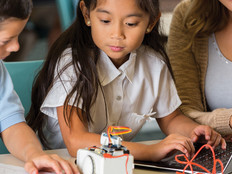Cross-Curricular Critical Thinking Is Integral to STEM Success
Whether you’re teaching STEM (science, technology, engineering and math), STEAM (STEM with art) or STREAM (STEAM with reading), the proof of success is in preparing students to be ready for everything.
While upgrading the acronym to include elements of visual learning and literacy shows that we’re striving for equal importance for all education topics, having a strong cross-curricular, well-rounded cohesive education is what is really important.
Helping students develop strong critical thinking and literacy skills will serve them well as they move from college to career.
Literacy Lets Students Learn Technical Skills Easier
Despite the “R” for reading in STREAM, literacy has so much more to do with writing, speaking, understanding arguments and being able to verbally and visually display information that’s found in a nontext format.
One of my favorite STEM lessons in exploring literacy is through creating something and then having students write out the directions on how to do it. As a student — and even as an adult — it’s difficult to be very specific and detailed in an explanation of how to do something. When a student is able to recreate the initial project through an explanation from other students, success is achieved.
This kind of technical writing is a huge deal. Many people who work in isolation and get all of their information via computer instead of hands-on demonstration from one person. These students will have to do a lot of independent learning that will require literacy. STEM lessons in writing out directions will help.
Critical Thinking and Problem-Solving Are Essential
Teachers are preparing students for jobs that don’t even exist yet. If we don’t know the coding language they are going to be using in 15 years, we need to teach them to be fluid and think critically.
The whole idea with STEM is that students need to figure out solutions to problems. They need to be the ones who are using critical-thinking skills and innovation. And, as teachers, we really have to give students the opportunity to be innovative. It’s not something that can be delivered to a student standing in the front of the classroom.
“I don’t know, but let’s figure it out,” is a great answer for a STEM teacher. For educators looking to foster these skills in their students, it shouldn’t be so much a lesson as it is an exploration in problem-solving, critical thinking and literacy.
This article is part of the "Connect IT: Bridging the Gap Between Education and Technology" series. Please join the discussion on Twitter by using the #ConnectIT hashtag.
![[title]Connect IT: Bridging the Gap Between Education and Technology [title]Connect IT: Bridging the Gap Between Education and Technology](http://www.edtechmagazine.com/k12/sites/default/files/articles/2014/05/connectit.jpg)








